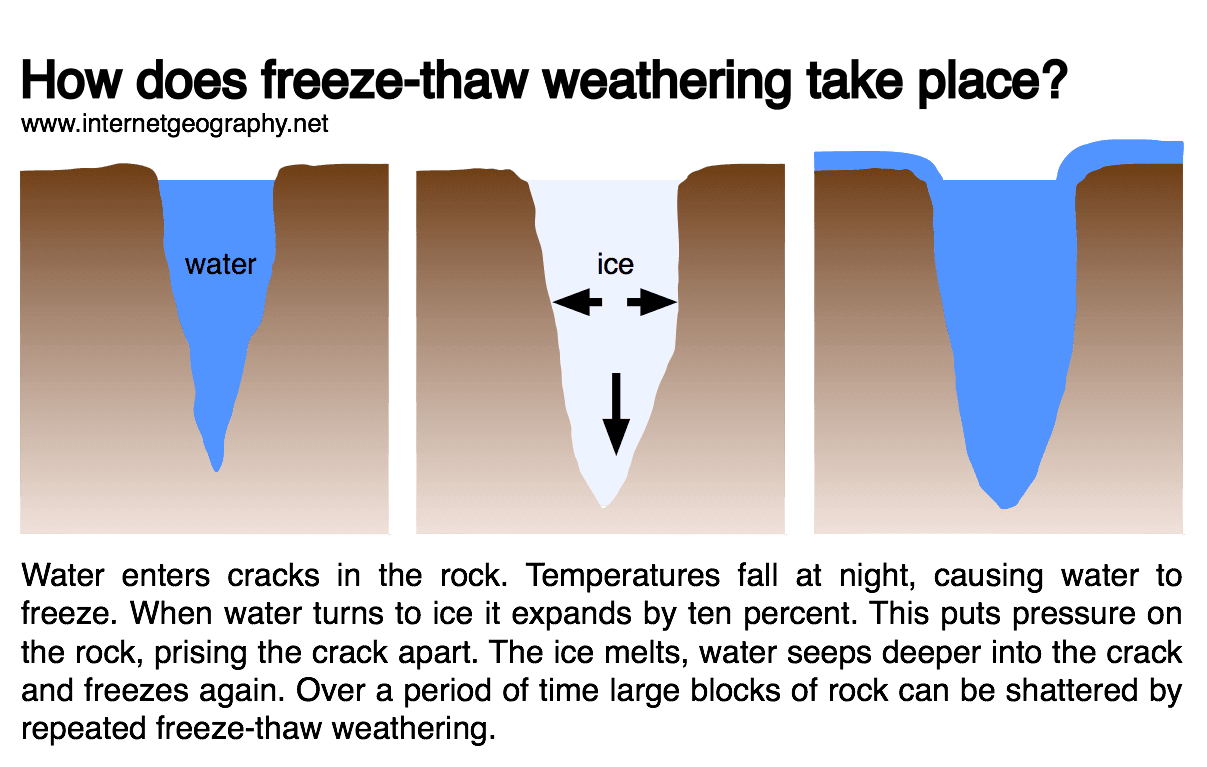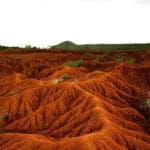Get ready to dive into the amazing world of weathering, where time works its magic on Earth’s landscapes! Think of it as nature’s own artist, creating masterpieces like mountains and coastlines. We’ll uncover the secrets of this awe-inspiring process, exploring how long it takes and the forces that shape its intensity. From the gentle touch of the wind to the mighty crashing of waves, we’ll reveal the silent sculptors behind these stunning transformations.
How Long Does the Weathering Process Take?
Ever wondered how majestic mountains transform into valleys, or how solid rocks crumble into tiny grains of sand? It’s all thanks to weathering – nature’s slow and steady sculptor. This process, where rocks, minerals, and soil break down over time, is like a patient artist, working over thousands, even millions of years, to reshape our planet.
So, what exactly drives this transformation? Imagine the relentless heat of the sun, the freezing grip of winter, the persistent force of wind and rain, and even the silent work of tiny plants and animals. These are the key players in the weathering process. Weathering processes, including physical, chemical, and biological forces, occur over vast time scales, ranging from thousands to millions of years.
Think of physical weathering like ice cracking a pavement. When water seeps into cracks and freezes, it expands, acting like a wedge that slowly breaks the rock apart. The gradual breakdown of rocks by repeated freezing and thawing cycles significantly contributes to weathering. On the other hand, chemical weathering is more like a rusting car. It involves reactions with water, air, or even living things that alter the very makeup of the rock, causing it to decompose.
Now, you might be thinking, “Okay, but how long does all this take?” Well, it’s a bit like asking how long it takes to bake a cake – it depends! A rock exposed on a mountaintop, battered by wind and ice, will weather much faster than one nestled in a valley. The type of rock matters too. Some rocks are tougher than others, putting up a good fight against the elements. The weathering of silicate rocks plays a critical role in the carbon cycle by releasing carbon dioxide into the atmosphere.
And let’s not forget the living world! Have you ever seen a tree root pushing through concrete? Plants and animals are surprisingly powerful weathering agents. Roots can grow into cracks, prying rocks apart, while burrowing animals help break down and mix the soil.
But weathering isn’t just about destruction. It’s a crucial part of creating the fertile soil that supports life. As rocks break down, they release valuable nutrients that plants need to grow. And of course, weathering shapes the landscapes we know and love – from towering cliffs to rolling hills, all sculpted by this ongoing process. Weathering is a fundamental process in the rock cycle, shaping the surface of the Earth and influencing sedimentation and soil formation.
Scientists are still working to understand the complexities of weathering and how it interacts with our changing climate. Exploring the specific environmental factors and their interactions that influence weathering rates is an ongoing area of study. But one thing’s for sure: this slow and steady force will continue to shape our planet for millions of years to come.
How Long Does Weathering Take?
So, we’ve been talking about weathering, right? How rocks break down and change over time. It’s a pretty slow process, though – we’re talking thousands, even millions of years for it to really reshape the landscape.
Think about it like this: physical weathering, where rocks are broken down by things like freezing water expanding in cracks or even tree roots growing – that can happen relatively quickly, especially in places with crazy weather swings. But even then, it’s not like watching a movie, more like watching a plant grow. You might not notice much day to day, but over time, the changes add up.
Now, chemical weathering? That’s a whole different story. This is where the actual chemical makeup of the rock is changing, usually reacting with water or stuff dissolved in it. This one is way slower, more like a slow dance than a sprint. Things like the climate, what the rock’s made of, and even if there are plants around can all speed it up or slow it down.
Scientists are still figuring out all the nitty-gritty details of how long weathering takes under different conditions. Investigating the impact of weathering on the release of other elements into the environment is a key area of focus. It’s a complex process with tons of variables, but that’s what makes it so fascinating! Each rock basically has its own story to tell about the forces that shaped it over eons.
Is the process of weathering fast?
So, we’ve been talking about weathering, the whole rocks breaking down thing. It’s a slow and steady process, right? Well, yes and no. It’s like asking how long a piece of string is – it depends! Weathering and erosion play crucial roles in shaping Earth’s landscapes and facilitating nutrient and element cycling.
Think about it like this. Imagine two rocks, one chilling in the scorching desert and the other hanging out on a frosty mountaintop. The desert rock has to deal with crazy temperature swings – baking hot during the day and freezing cold at night. All that expanding and contracting can make it crack and crumble faster. That’s physical weathering in action, and it usually happens quicker in colder climates where temperature changes are more extreme. Physical weathering involves the mechanical breakdown of rock, while chemical weathering involves chemical reactions.
Now, our mountain rock friend has a different story. It’s more about slow and steady chemical reactions. Rain, especially slightly acidic rain, can react with the rock, slowly dissolving it over time. This chemical weathering is more common in warm, wet places. It’s a bit like how a sugary drink might eventually eat away at your teeth if you don’t brush (yikes!).
But wait, there’s more! The type of rock matters too. Some rocks, like limestone, are softer and break down more easily. It’s a bit like the difference between crumbling a cookie and trying to break a rock-hard candy. Harder rocks, like granite, are tougher cookies to crumble and can withstand weathering for much longer. Freeze-thaw cycles, temperature fluctuations, and water absorption by materials contribute to physical weathering.
And then there’s the environment. A rock constantly blasted by wind and rain is going to weather faster than one tucked away in a sheltered spot. Think about how much faster a wooden fence would rot if it’s always exposed to the elements! Similarly, salty air or acidic rain can really speed up the weathering process – they’re like little rock-eating ninjas! Chemical weathering occurs through reactions with water, atmospheric gases, and biological chemicals.
Even plants can get in on the action! As they grow, their roots can wedge into cracks, prying rocks apart. Plus, they release chemicals that can contribute to weathering, slowly breaking down rocks over time.
The bottom line is that weathering can be a slow burner, happening over thousands or even millions of years. But certain conditions, like extreme weather or human activities, can really crank up the speed. It’s a complex process with a lot of factors at play, and scientists are still learning more about it every day. Exploring the impacts of weathering and erosion on specific geological formations or ecosystems could provide unique insights. The article could delve into the potential effects of climate change on weathering and erosion rates.
How does weathering process?
We’ve talked about weathering before, but let’s really dive into how this process actually happens. It’s like a never-ending game of tug-of-war between rocks and the environment. Weathering involves physical and chemical processes that break down and dissolve rocks and minerals on Earth’s surface.
Think of a rock out in the open. Over time, it goes through a lot, like scorching sun, freezing rain, and maybe even a tree root trying to muscle its way through. All of these things, and more, contribute to the weathering process.
Physical Weathering: Nature’s Brute Strength
Imagine a rock getting constantly bombarded by the elements. That’s physical weathering in a nutshell! It’s all about the physical forces that break down rocks without changing their chemical makeup. Physical weathering, a mechanical process, disintegrates rocks without altering their chemical composition, such as through temperature changes or water freezing and expanding.
- Temperature Swings: Heat makes things expand, and cold makes them contract. Rocks are no different! Imagine a rock baking under the hot sun. Its outer layers expand. Then, when the sun sets and things cool down, those layers contract. This constant expanding and contracting can cause cracks to form, kind of like when you bend a plastic straw back and forth too many times.
- Water’s Power: We all know water is powerful, but did you know it can actually break rocks? It’s true! When water seeps into cracks in a rock and then freezes, it expands. This expansion puts incredible pressure on the rock, eventually causing it to break apart, just like an ice cube tray in the freezer.
- The Root of the Problem: Ever seen a tree growing on a rocky cliff? Those roots are surprisingly strong. As roots grow, they can wedge themselves into cracks in rocks and pry them apart. It’s a slow process, but over time, it can cause significant weathering.
Chemical Weathering: A Matter of Chemistry
Chemical weathering is a bit more subtle. This type of weathering involves chemical reactions that actually change the composition of the rock. Chemical weathering involves reactions between rocks and soils with water, atmospheric gases, and biologically produced chemicals.
- Acid Rain: Pollution can mix with rain, creating a weak acid that falls back to Earth. When this acidic rain falls on rocks, it can dissolve some of the minerals in the rock, weakening it and making it more susceptible to other forms of weathering.
- Water’s Chemical Role: Water isn’t just a physical force; it’s a powerful solvent too. It can dissolve certain minerals in rocks, especially over long periods. Imagine a sugar cube dissolving in water—it’s a similar idea, just much slower!
- Oxygen’s Bite: Rust is a great example of chemical weathering in action. When iron in rocks is exposed to oxygen and water, it forms iron oxide, which is what we know as rust. Rust makes the rock weaker and more likely to crumble.
The Big Picture: Why Weathering Matters
So, weathering breaks down rocks, but why should we care? Well, it’s a much bigger deal than you might think! Weathering plays a vital role in shaping our planet: Weathering plays a crucial role in the rock cycle, influencing the formation of sedimentary rocks that cover a significant portion of Earth’s landmasses and seafloor.
- Soil Formation: Weathering is essential for creating soil. As rocks break down, they provide the minerals and nutrients that plants need to grow. No weathering, no soil, no plants – you can see where this is going!
- Landform Sculpting: Think of those majestic mountains and valleys we admire. Weathering is a key player in shaping those dramatic landscapes over millions of years. It’s like nature’s slow-motion art project!
- Nutrient Cycling: Weathering helps release important nutrients from rocks, making them available to plants and, eventually, to us!
Unraveling the Mysteries of Weathering
Scientists are still learning about the intricate processes of weathering. Investigating the specific chemical reactions and their relative contributions to chemical weathering in different geological contexts is an active area of research. For example, did you know:
- The rate of weathering can vary depending on the type of rock? Some rocks are tougher than others.
- Climate plays a huge role? Hot, humid environments tend to see faster chemical weathering, while cold, dry places might experience more physical weathering. Exploring the impact of climate change on weathering processes, considering rising temperatures, altered precipitation patterns, and increased atmospheric CO2 levels, is crucial for understanding future environmental changes.
- Even living things contribute to weathering? Lichen, a combination of algae and fungi, can release acids that break down rocks. Examining the interplay between weathering and soil formation, and its implications for soil health and agricultural productivity, is essential for sustainable land management.
Weathering is a complex and fascinating process that’s crucial to life as we know it. It’s a constant reminder that our planet is dynamic and ever-changing, shaped by forces both powerful and subtle.
Does Weathering Take Thousands of Years?
So, we’ve been talking about weathering, the incredible process that shapes our planet’s landscapes. But have you ever wondered how long it actually takes? Does it really take thousands of years for a mountain to crumble, or a canyon to carve its way through rock? Weathering is the breakdown or alteration of rocks and minerals on Earth’s surface due to exposure to physical and chemical agents.
The short answer? It depends! Weathering isn’t a one-size-fits-all kind of thing. It’s more like a slow, steady dance between the Earth and its environment.
Think about it this way: imagine a rock out in the open. Now, picture that rock getting rained on, baked by the sun, and frozen in the winter, year after year. Over time, these things start to take their toll. The rain might be slightly acidic, slowly dissolving some of the minerals in the rock. The sun’s heat can cause the rock to expand and contract, creating tiny cracks that get bigger over time. And when water seeps into those cracks and freezes, it expands, acting like a wedge that gradually splits the rock apart.
That’s the gist of how physical weathering works – it’s like the Earth is slowly chipping away at the rock, bit by bit. Physical weathering physically breaks down rocks, while chemical weathering alters their chemical composition.
But there’s more to the story! Remember chemical weathering? That’s where things get a little more complex. Imagine that same rock, but this time, picture the rainwater reacting with the minerals inside, changing their composition. Or think about plants growing on the rock, their roots releasing chemicals that break down the rock’s surface. These chemical reactions can weaken the rock even faster, making it more susceptible to physical weathering as well.
Now, here’s the thing: the speed of weathering depends on a bunch of factors. Different types of rock weather at different rates. A soft rock like sandstone is going to break down much faster than a hard rock like granite. Climate plays a huge role too. A hot, humid environment is going to speed up weathering because those conditions accelerate chemical reactions. On the other hand, a cold, dry climate might slow things down. Weathering processes shape the landscape, influence soil formation, and contribute to the composition of the atmosphere and ocean.
So, back to our original question: does weathering take thousands of years? Well, it can! It often does, especially when we’re talking about large-scale changes to landscapes. But it’s not always a waiting game that takes millennia. Smaller-scale weathering can happen much faster, even within a human lifetime. For example, you might notice a small rock in your backyard gradually breaking down over a few years. Weathering plays a crucial role in regulating Earth’s climate and ecosystems over geological timescales.
Here’s the most important thing to remember: weathering is a continuous process, a constant interplay between the Earth’s materials and its environment. Sometimes it’s a slow and subtle transformation; other times it’s a dramatic reshaping. And while scientists have learned a lot about how weathering works, there’s still so much more to discover. Every rock, every landscape, has a story to tell about the powerful forces that have shaped our planet over time. Exploring the role of weathering in climate regulation, particularly the carbon cycle and its potential for mitigating climate change, is crucial for understanding Earth’s climate system. Investigating the impact of human activities on weathering processes, such as pollution and land-use changes, is essential for assessing our environmental impact. Additionally, examining the applications of weathering knowledge in industries such as construction, mining, and agriculture can lead to more sustainable practices.
Eager to discover which of the following is an example of chemical weathering? Delve into the details and unravel the fascinating processes that shape our planet’s surface.
Curious about how wind, rain, and waves contribute to the relentless force of weathering? Embark on an exploration to unveil the mechanisms by which these elements sculpt and transform the Earth’s landscapes how do wind rain and waves cause weathering.
- Sept 31 Myth: Unveiling Calendar Secrets - March 18, 2025
- How Long & Till December 18, 2025: Accurate Countdown Guide - March 18, 2025
- Discover Japanese Artists: A Complete History - March 18, 2025

















1 thought on “Deciphering Time’s Embrace: How Long Does the Weathering Process Take?”
Comments are closed.